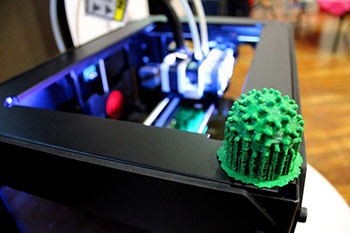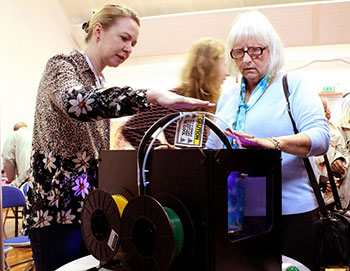| Oct 31, 2014 |
3D printed giant germs help visually impaired see the world of microorganisms
|
|
(Nanowerk News) Last Friday BBSRC and scientists from Oxford Brookes University teamed-up to run Giant Germs – an event tailored specifically to the blind and visually impaired. The day allowed visitors to discover the microscopic world of bugs and germs for the very first time thanks to 3D printing technology.
|
 |
| A 3D printer used to print bugs and germs. (Image: BBSRC)
|
|
The event kicked off with talks on how parasites and viruses can infect our cells and their impact on the world around us. Amongst the nasties mentioned were the human papilloma virus (HPV) which causes cervical cancer, as well as the parasite that causes the fatal African "sleeping sickness".
|
|
The discussions were supported by tactile sessions with 3D models of the viruses and parasites, enabling the visitors to feel the detailed structures of different cell types.
|
|
Professor Chris Hawes, the Director of Life Science Research at Oxford Brookes University said: "The 3D structures developed by Dr Louise Hughes and team allow individuals with visual impairments the unique opportunity to access the world of microscopy, a typically visually dependent field, as they are able discover the structure of microorganisms for the very first time."
|
|
For most of the visitors, it was the first time they had ever had the chance to explore microscopes or identify with virus structures.
|
 |
| Blind and visually impaired guests, hearing and feeling the heat of the 3D printer. (Image: BBSRC)
|
|
Simba Ngwarati, a guest from the Thomas Pocklington Trust said: "I enjoyed today a huge amount because before I came here, I had never studied any science. This is the first time that anyone has come and shown us what some researchers do in the lab, which was very interesting!"
|
|
To shrink the models down to size, the researchers explained that if the 3D printed cells were life size, the equivalent average human height would be the distance between London and Athens. This perspective helped everyone to appreciate the tiny scale at which these germs interact with our bodies.
|
|
Jackie Hunter, BBSRC Chief Executive said: "This was a wonderful opportunity to engage with the public in a totally different way and highlights the great things to come at the Great British Bioscience Festival."
|
|
Dr Louise Hughes who runs the Bioimaging Unit at Brookes has now received international accolade, winning a prestigious New England Biolabs – Passion in Science Award. The award acknowledges the ground-breaking work using 3D printing to make microscopy accessible for all.
|
|
The scientists from Oxford Brookes will be showcasing their Giant Germs exhibit alongside 19 other exciting exhibits from across the UK at the Great British Bioscience Festival in Museum Gardens, Bethnal Green, 14-16 November.
|


